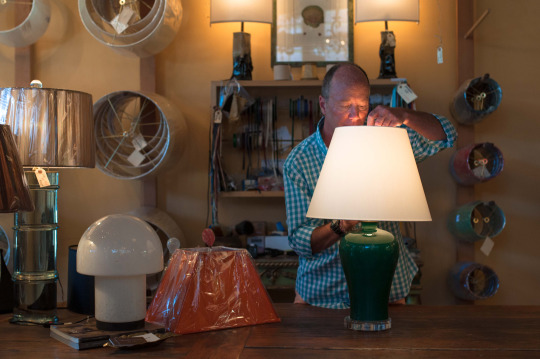Designers know that lighting is the key to creating a gorgeous space. And nothing impacts the quality of light like a lamp shade, particularly on table lamps.
To find out how to create those warm, glowing pools of light that sexify a room, we turned to expert Robb Lee Mills, a 6-year veteran at San Francisco’s Dogfork Lamp Arts and the interior design community’s go-to resource for all things lamp shade. Here’s a simple reduction of all his wisdom for you to keep in mind when you are looking for that perfect shade.

Robb’s three rules for choosing a lamp shade:
- Bring the lamp with you to the lamp shade store.
- Experiment with different shapes, proportions, materials and color while also keeping in mind the practicalities of necessary light output.
- After you choose your shade, decide on the harp to determine the height of the shade.
What goes with what? To show us some basic shapes of tables lamps and suggested lamp choices, Robb presented us with some perfect pairings and unexpected findings.
Mid Century Long Necked Table Lamp:
4 Ways
Drum: A round shade with no slant delivers a clean and modern look. Drum shades come in different heights which affect the look radically:

A rectangular lamp shade lends the lamp a contemporary look:

Cylinder shades are essentially a tall drum shade that covers the neck and guts of a lamp for a clean, modern impression. A tall cylinder shade adds modernity and crispness:

A custom cone or extra deep empire shade makes it taller and more exaggerated for a 100% swanky look:

The Ginger Jar Table Lamp: 4 Ways
Oval shades look round from the front but take up a lot less space.
Pro Tip: These are a great choice for bedside tables and end table where there is constrained depth; you can place these lamps much closer to the wall and free up valuable table surface space:

Empire: Any shade with a slant is considered “Empire.” There are plenty of variations, like the rectangular empire below (and we love this pop of color):

Modified empire: This shade has a less steep slant than most other empire shades. Its incredibly un-politically correct nickname is a “coolie shade.” You will see these frequently used by the iconic John Saladino in a paper finish:

Pagoda shade: Empire with flipped corners that turn up in a traditional chinoiserie style:

Shield (pictured here on the amazing black cat lamp): A traditional Venetian look, also great for table lamps that will be back against a wall (like in on a console table or buffet). You will also see shield lamp shades on sconces:

Other Considerations
Fabric Choice

When a lamp shade is illuminated, the texture of the fabric really shows so consider first how much variation you want.
Silk lamp shades come in a range of textures from slubby dupioni to a smooth pongee. Offering a slight sheen, this is a grown up look.

Linen lamp shades all have some texture, with burlap being the most variegated, and know that linen withstands sun better than silk.

Parchment or Paper Shades don’t illuminate too much and so create a similar dramatic effect to a lined shade, but wow! so they darn modern and especially in a fabulous color. Also, usually the most affordable choice!
Edges
Rolled lamp shade edges create a smooth finish where the fabric terminates with a neat roll over the end of the shade leaving a seamless edge. Single Fold lamp shade edges feature visible seams like a border, often in a separate color as piping or trim.
Linings
Lined lamp shades change the color of the light as well as create a nice surprise if you see them from the top. Consider this for the interior of a low lamp you see from above.

Gold linings and black shades are are the glamour choices! Both make the shade opaque and dramatically force the light out the top and the bottom, create a spotlight on the table surface and uplight the wall. Va voom!

Trims
Trims are a reliable way to create a custom and highly finished look with some serious style chops.

Consider a narrow trim in a contrasting color using one, two or even three rows of narrow ribbon.

Placed at the bottom of the shade, it exaggerates the height. At both the top and bottom, you’ll get a preppy, tailored look. And just at the top, you will bring the height of the shade down.

Thank you, Robb and Dog Fork Lamp Arts for teaching us all about the incredible transformative lamp shade!












